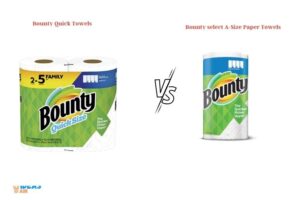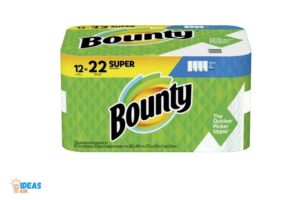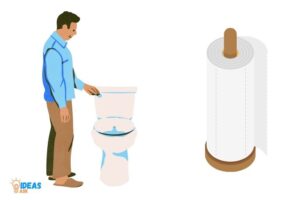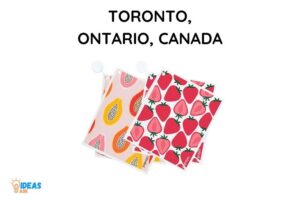Why Do Paper Towels Have Patterns? Increase Absorbency!
Paper towels have patterns to increase absorbency and improve their overall effectiveness.
These patterns create channels and pockets in the paper that aid in the rapid absorption of liquids and spills. The texture formed by the patterns allows the towels to efficiently trap and hold moisture.
As a result, they can effectively clean up messes and provide a better user experience. These functional patterns enhance the paper towels’ performance in various cleaning tasks.

Key Takeaway
Exploring The Purpose And History Of Patterns On Paper Towels
Have you ever wondered why paper towels have patterns on them? It turns out that there is more to it than just aesthetics.
We will explore the purpose and history of patterns on paper towels.
Definition Of Paper Towel Patterns
Before we dive into the history of patterns on paper towels, let’s define what we mean by patterns. Paper towel patterns refer to the various designs and textures that are imprinted on the paper. These can range from simple embossed lines to intricate designs.
Historical Evolution Of Paper Towels, From Simple To Patterned
- Paper towels were first invented by Arthur Scott in 1907. They were originally just simple rectangular sheets of paper used for drying hands.
- However, over time, paper towels have evolved to become more absorbent and versatile, with the addition of patterns being one of the many improvements.
- In the 1930s, paper towels began to feature simple embossed lines to improve absorption capacity.
- By the 1950s, more intricate patterns were being added, not only to increase absorbency but also to enhance the appearance of the paper towel.
Overview Of How Patterns On Paper Towels Are Created
Paper towel patterns are created using two methods: embossing and printing.
- Embossing involves pressing the paper towel between two metal rolls, with the desired pattern etched into the rolls. This creates a 3d effect on the paper, improving its ability to absorb liquids.
- Printing involves adding the pattern using ink that is transferred onto the paper. This method allows for more intricate designs and greater customization options.
The patterns on paper towels go beyond just aesthetics. They have evolved over time to improve the towel’s absorption capacity, functionality, and appearance.
Whether you prefer simple lines or intricate designs, there is no denying the importance of patterns on paper towels in our daily lives.
Understanding The Functionality Of Paper Towel Patterns
Have you ever wondered why paper towels have patterns on them? These patterns are not just for visual appeal, as they serve specific purposes.
We will delve into the functionality of paper towel patterns and how they make these absorbent products more useful.
Highlight Specific Benefits Of Paper Towel Patterns
The pattern on paper towels offers numerous benefits, which include:
- Improved aesthetics: Paper towel patterns make them more visually attractive, thereby making them more appealing to customers.
- Water resistance: Patterns help to prevent water from soaking through the paper, thereby improving their durability, and making them ideal for cleaning up spills more efficiently.
- Strength: The embossed patterns on paper towels enhance their structural integrity, making them resistant to tearing and ripping during use.
- Better cleaning performance: The textured pattern on paper towels helps to lift and trap dirt and bacteria effectively, which makes cleaning a breeze, leaving surfaces cleaner in a short time.
Explanation Of How Patterns Enhance The Absorbency And Strength Of Paper Towels
- The main function of paper towels is to absorb spills.
- The patterns on paper towels improve their absorbency by creating more surface area where the liquid can be absorbed.
- The embossed patterns on paper towels make the paper thicker, denser, and more substantial, which helps to increase their strength, thus guaranteeing their durability even when exposed to heavy spills.
Detailed Discussion Of How Patterns Help Combat Paper Towel Waste
- The texture on paper towels is essential in waste reduction because it can help prevent users from using more than they need.
- The patterns make it easier to tear off a single paper towel at a time, thus reducing waste.
- Besides, paper towel patterns can prevent users from tossing them out prematurely by ensuring that each sheet performs its intended function to the end.
- Finally, the patterns help to improve the quality and performance of paper towels, ensuring that users will need fewer of them to complete their cleaning projects.
How Patterns Keep Paper Towels From Sticking Together In Rolls?
- A common problem with plain paper towels is that they often stick together in rolls, leading to frustration and time wastage.
- The patterns on paper towels help to combat this issue by separating the sheets and preventing them from sticking together in rolls.
- At the manufacturing stage, paper towel patterns are designed, such that they adhere to the precise gap between sheets.
The patterns on paper towels are not just for aesthetic purposes but serve real functional benefits. The patterns help to improve the absorbency, strength, and cleaning power of paper towels, combat their waste, and keep them from sticking together in rolls.
What Do Paper Towel Patterns Really Mean?
Have you ever wondered why paper towels have patterns? You might think that it’s just a design choice, but there’s actually a lot of psychology and marketing behind it.
Let’s take a closer look at what these patterns really mean, how manufacturers decide on them, and how to choose the right pattern for your needs.
Analysis Of Consumer Psychology Behind Paper Towel Patterns
- Consumers like to see something visually appealing, even when it comes to disposable items such as paper towels.
- Patterns can evoke emotions and affect the perceived quality of the product.
- Psychological research shows that people tend to associate geometric shapes and patterns with strength and durability, while softer, curvier shapes and patterns are associated with comfort and gentleness.
- Studies also indicate that people prefer designs with moderate complexity, rather than plain or too intricate designs.
Explanation Of How Manufacturers Determine The Types Of Patterns To Use
- Manufacturers consider the target audience for each type of paper towel, as well as the intended use cases.
- Patterns should match the brand’s image and messaging (for example, a brand that emphasizes eco-friendliness might choose earthy colors and natural motifs).
- Market research and consumer surveys are used to determine which patterns are most appealing and effective in terms of sales.
How To Match Pattern Types To Specific Use-Cases?
- For messes that require a lot of scrubbing and wiping, choose a paper towel with a strong, geometric pattern that suggests durability.
- For spills or messes that require gentler handling (such as cleaning a child’s face), choose a paper towel with a softer, curvier pattern that suggests a gentle touch.
- For household tasks that require an extra degree of attention to hygiene (like cleaning up after handling raw meat), choose a paper towel with a pattern that clearly shows when it’s time to dispose of it.
Discussion On Current Market Trends For Paper Towel Patterns
- Modern patterns are moving away from floral, frilly designs and toward simpler geometric shapes, often arranged in a more artistic way.
- Trending color palettes include pastels, bright neons, and earthy neutrals.
- Brands are also experimenting with patterns that mimic natural materials, such as wood grain or marble.
Next time you reach for a roll of paper towels with a pattern, take a closer look at what it communicates and how it might affect your perception of the product.
Whether you’re a homeowner or a manufacturer, understanding the psychology of these designs can help you make better choices.
Do All Paper Towels Need Patterns?
Have you ever given serious thought to the intricate patterns found on paper towels? It turns out that they serve a vital purpose in the manufacturing process.
Investigation Of Paper Towel Brands That Choose To Remain Pattern-Free
While most paper towel brands have some type of design imprinted on their product, there are some that opt to remain pattern-free.
Some of these brands include:
- Whole foods market 365 everyday value
- Seventh generation
- Trader joe’s
- Viva
Benefits And Drawbacks Of Pattern-Less Paper Towel Alternatives
The choice between patterned and pattern-less paper towels comes down to personal preference.
Here are some benefits and drawbacks of pattern-less paper towels:
Benefits:
- Plain design may be more aesthetically pleasing to some people.
- Lack of pattern means less ink used in manufacturing.
- No risk of ink running onto surfaces when paper towel is wet.
Drawbacks:
- Pattern-less paper towels may be perceived as less absorbent by consumers.
- Lack of design may make it difficult to see any spills or messes on the towel.
How To Choose Between Patterned And Pattern-Less Paper Towels Based On Consumer Needs (Roi Analysis)
When it comes to choosing between patterned and pattern-less paper towels, it all boils down to the return-on-investment (roi) for the consumer.
Here are some things to consider:
- Are looks important? If so, a pattern-less paper towel may be the way to go.
- Is absorbency the top priority? Consumers looking for a highly absorbent paper towel may gravitate towards a patterned option.
- Is eco-friendliness important? Choosing a pattern-less paper towel may reduce ink usage and have less impact on the environment.
Choosing between patterned and pattern-less paper towels ultimately depends on the consumer’s personal preference and needs. Whether you opt for a patterned design or a plain one, both options provide excellent functionality.
So, next time you wipe up a mess, take a moment to appreciate the thought and effort put into that tiny paper towel pattern.
Wrap-Up Of The World Of Patterns On Paper Towels
From the early days of paper towel production, paper towels have been a household staple due to their exceptional absorbency capabilities.
However, it’s the patterns on paper towels that pique our interest and make them stand out from other absorbent materials.
We’ll delve into current and future market trends, and explain how consumer psychology and manufacturers factor into the production of paper towel patterns.
Lastly, we’ll discuss how paper towel patterns might change in the future.
Discussion On Current And Future Market Trends Of Paper Towel Patterns
- Today’s paper towel market is flooded with a wide range of patterns from plain to coloured to imprinted designs.
- The trend towards eco-friendly and sustainable products has led to a growing demand for recycled paper towel patterns.
- With the current push towards sustainability, there’s a move towards using bamboo and sugarcane bagasse pulp to create patterned paper towels.
- Manufacturers are also experimenting with augmented reality and mobile apps to provide an enhanced user experience with paper towels.
How Patterns Might Change In The Future
- Continuous research and development of patterns on paper towels with innovations such as augmented reality and responsive mobile apps will provide an enhanced user experience.
- The patterns on paper towels will continue to evolve to meet the diverse needs of consumers, including those with an interest in eco-friendly and sustainable products.
Paper towel patterns are much more than just a pretty design. They’re an integral part of the product’s functionality, economics, and user experience.
With today’s advancements in technology and sustainability concerns, the world of paper towel patterns is just getting started.
Conclusion
To conclude, while paper towels may seem like a simple and mundane household item, they actually have an interesting history and purpose.
The patterns on paper towels provide both aesthetic appeal and functional benefits that improve their absorbency and strength.
The patterns on paper towels can signify the specific intended usage of the towel, whether it be for cleaning up spills or for gentle facial wiping.
Nowadays, paper towels continue to evolve with advancements in technology and sustainability efforts, leading to the development of eco-friendly and reusable options.
Ultimately, understanding the purpose of paper towel patterns can help individuals make informed decisions about the products they use and can contribute to reducing waste.
Overall, the next time you reach for a paper towel, take a moment to appreciate its design and the thought that went into making it an effective tool for daily use.






